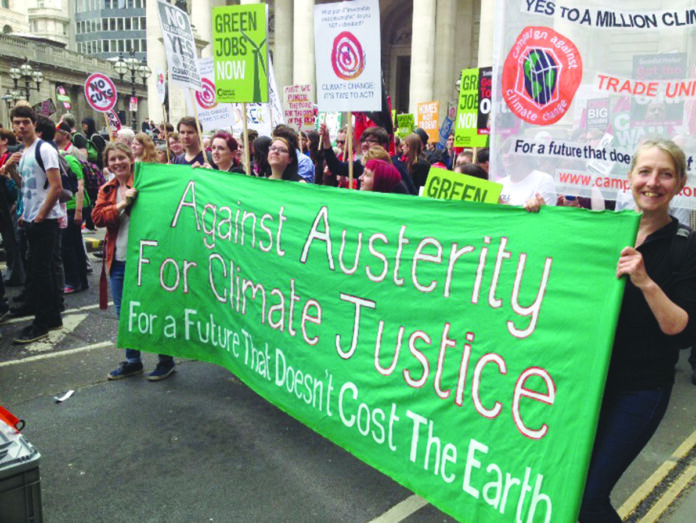‘Global temperatures are likely to soar to record highs over the next five years, driven by human-caused warming and a climate pattern known as El Niño, forecasters at the World Meteorological Organization said on Wednesday. The record for Earth’s hottest year was set in 2016. There is a 98 percent chance that at least one of the next five years will exceed that, the forecasters said, while the average from 2023 to ’27 will almost certainly be the warmest for a five-year period ever recorded.’ – An excerpt from a May 17 New York Times published article ‘Heat will likely soar to record levels in next 5 years, new analysis says’
Climate change crisis, which for a number of years has been fast-unfolding, requires not only shifting towards a green economy, with a clean source of energy, and production and consumption decisions that put carbon emission on a downward trajectory, but doing it in a much high-paced way. This is because global warming levels already reached– average annual temperatures have already risen 1.1°C over the pre-Industrial Revolution age– have been producing strong and frequent heatwaves, in turn, creating serious dangers for life, but if they exceed the threshold of 1.5°C, will most likely put global warming on an irreversible trajectory; where the window of opportunity to avoid this catastrophic eventuality is fast closing, and by majority scientific consensus this may just most probably take another decade if serious policy course-correction is not adopted.
That policy requires moving away from the fossil-fuel based economy, especially by rich, advanced countries, which mainly requires greater climate-related investments, or climate finance, along with more purpose-driven governments, multilateral spirit, and domestic and international economic institutional quality. Two things need to happen mainly, and the 28th edition of the Conference of Parties (COP28), to be held in Dubai Expo City (UAE) during November 30–December 12 this year, should be used appropriately for this. First, there needs to be unanimity of voice by countries in terms of sound commitment to reduce fossil-fuel reliance at the earliest. Secondly, the global financial architecture is reformed accordingly.
In the recently held global conference in this regard in Paris, titled ‘Summit for a New Global Financial Pact’, President Macron of France reportedly indicated that rich, advanced countries would fulfill their commitment to provide $100 billion annually to developing countries. He reportedly pointed out in this regard: ‘During this Summit, we obtained very concrete things. We finalized the long-awaited $100 billion climate finance pledge.’ Here, it needs to be mentioned that according to this commitment, rich, advanced countries had committed to provide the said amount starting 2020, but are yet to come good on this.
A global architecture based on mainly neoliberal precepts, and within it primarily, market fundamentalism, and austerity policies has reduced economic resilience– due to investments following mainly profits, and short-termism– and increased income and wealth inequality. Hence, the diminishing role and capacity of government over the last four decades or so– a time period during which the neoliberal assault got mainstreamed into public policy– has resulted in a weak build-up of sectors like health, and overall weak public sector service delivery, and fewer opportunities for more inclusive growth, which have put the public in a very vulnerable position to deal with the existential threats like climate change– and meaningfully generating from it the significant phenomenon of Pandemicene.
Although there has been a significant backlash to neoliberal, and austerity policies in the wake of Global Financial Crisis 2007-2008, and more recently in the wake of the covid-19 pandemic, the across-the-board practice of monetary tightening by major central banks, and followed quite fervently by developing countries, not to mention the over-reliance of policy prescribed by IMF on a neoliberal and austerity thought process, has resulted in inadequate climate budgets, especially in the case of developing countries.
The lack of a proper debt relief/moratorium initiative by major bilateral and multilateral creditors, and inadequate provision of climate finance, has also put a greater burden on countries to adopt deep austerity policies, which is not the right way to go, especially for highly climate vulnerable countries like Pakistan.
Moreover, the rising frequency and intensity of global heat waves, including the formation of ‘heat domes’ has all the more placed focus on greater climate-related investments, but a weak spirit of multilateralism– seen glaringly in the less than optimal way of covid-19 vaccine production and distribution decisions during the pandemic, and lack of provision of climate finance by rich countries– and fighting inflation through primarily monetary and fiscal policies, has left little fiscal space for especially highly climate-vulnerable developing countries, like Pakistan.
In addition, high interest rates have also put greater pressure on domestic financial resources of countries, and that is through increasing external- and domestic debt burdens of countries both generally, but especially of those developing countries like Pakistan, which were already debt distressed before the recession-causing, and greater welfare-needs generating covid-19 pandemic.
Moreover, the lack of a proper debt relief/moratorium initiative by major bilateral and multilateral creditors, and inadequate provision of climate finance, has also put a greater burden on countries to adopt deep austerity policies, which is not the right way to go, especially for highly climate vulnerable countries like Pakistan.
They, on the contrary, need to make high level of climate resilience-creating investments, and where anyways greater monetary austerity is a misplaced policy option even when seen in the traditional sense– not to mention all the more in the wake of a global supply crisis since the heydays of the pandemic, and accentuated by the war in Ukraine– given inflation being at least equally a fiscal, governance-related, supply-sided phenomenon.























